tire pressure VOLKSWAGEN GOLF PLUS 2006 Owners Manual
[x] Cancel search | Manufacturer: VOLKSWAGEN, Model Year: 2006, Model line: GOLF PLUS, Model: VOLKSWAGEN GOLF PLUS 2006Pages: 541, PDF Size: 98.86 MB
Page 15 of 541
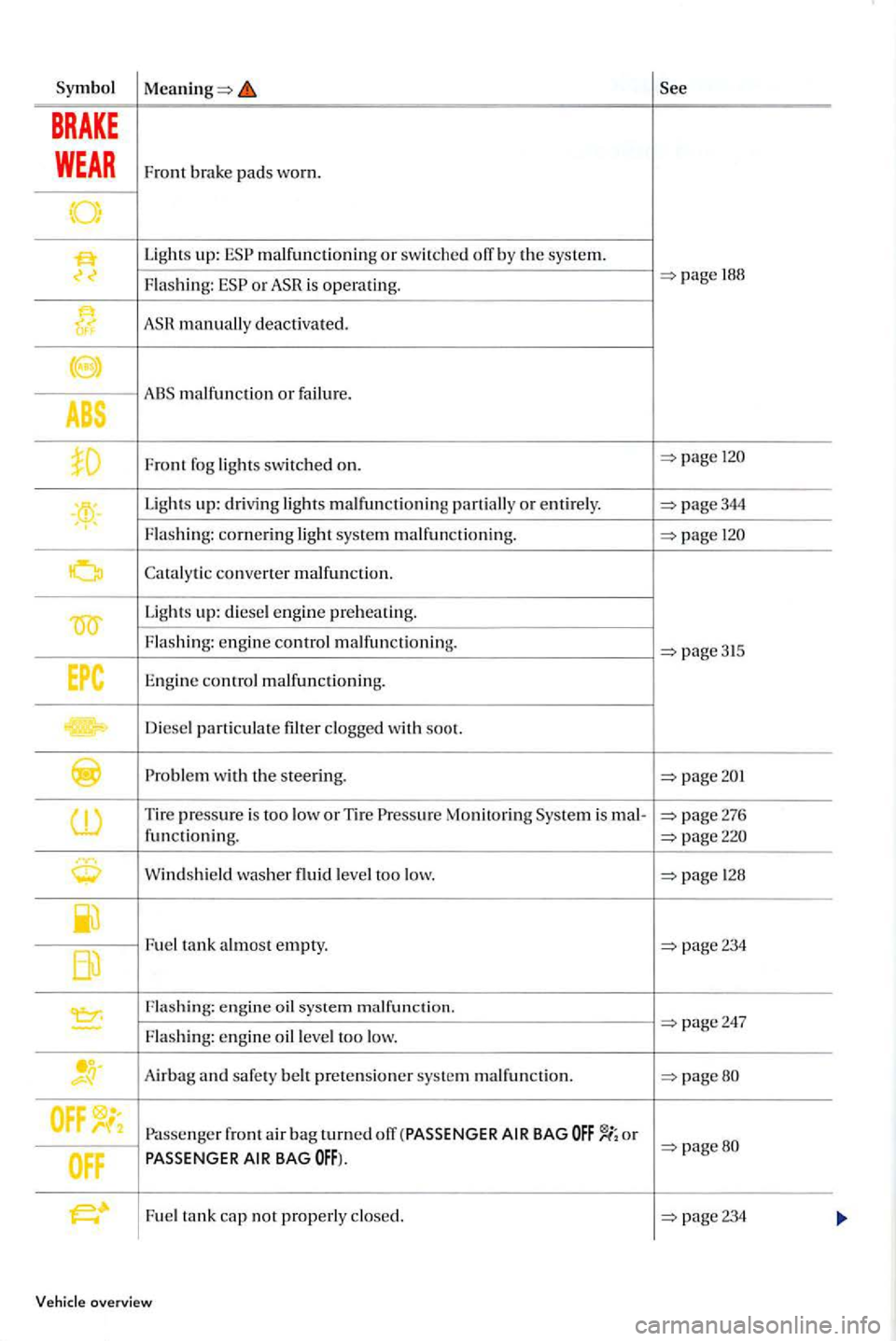
Symbol
BRAKE
WEAR Fro nt brake pads wo rn.
Lights up: malfuncti oning or sw itched o!T b y th e system.
Flashing: or 188
manually deactivated.
malfunction or fail ure.
Fr ont fog lights switch ed on.
Ligh ts up: driving lights m alfunctioning parti ally or en tirely . page344 ! Flashing: cornerin g light system malfun ctionin g. 120
converter malfunction.
Lig ht s up: die sel eng in e preheati ng.
F l
ashi ng: en gin e contro l malfunctio ning. page315
Engine control malfunctionin g.
D i
esel p a rt ic u la te filt er clogged with soot.
with the s teering.
Tir e pressure is too low or Tire Monitoring Syste m is page276
fun ctioning.
Wind shi eld was he r fluid level too low. 1 28
F u e l tank a lmost empty. page234
Fla sh ing: engin e oil system malfunct io n. page247 -Fla sh in g: en gin e oil level too low.
A irba g and safety belt pretensio ne r sys te m malfunction. page80
Passenger front air bag turned o!T o r page80
Fuel t an k cap not properly c losed.
overview
Page 33 of 541
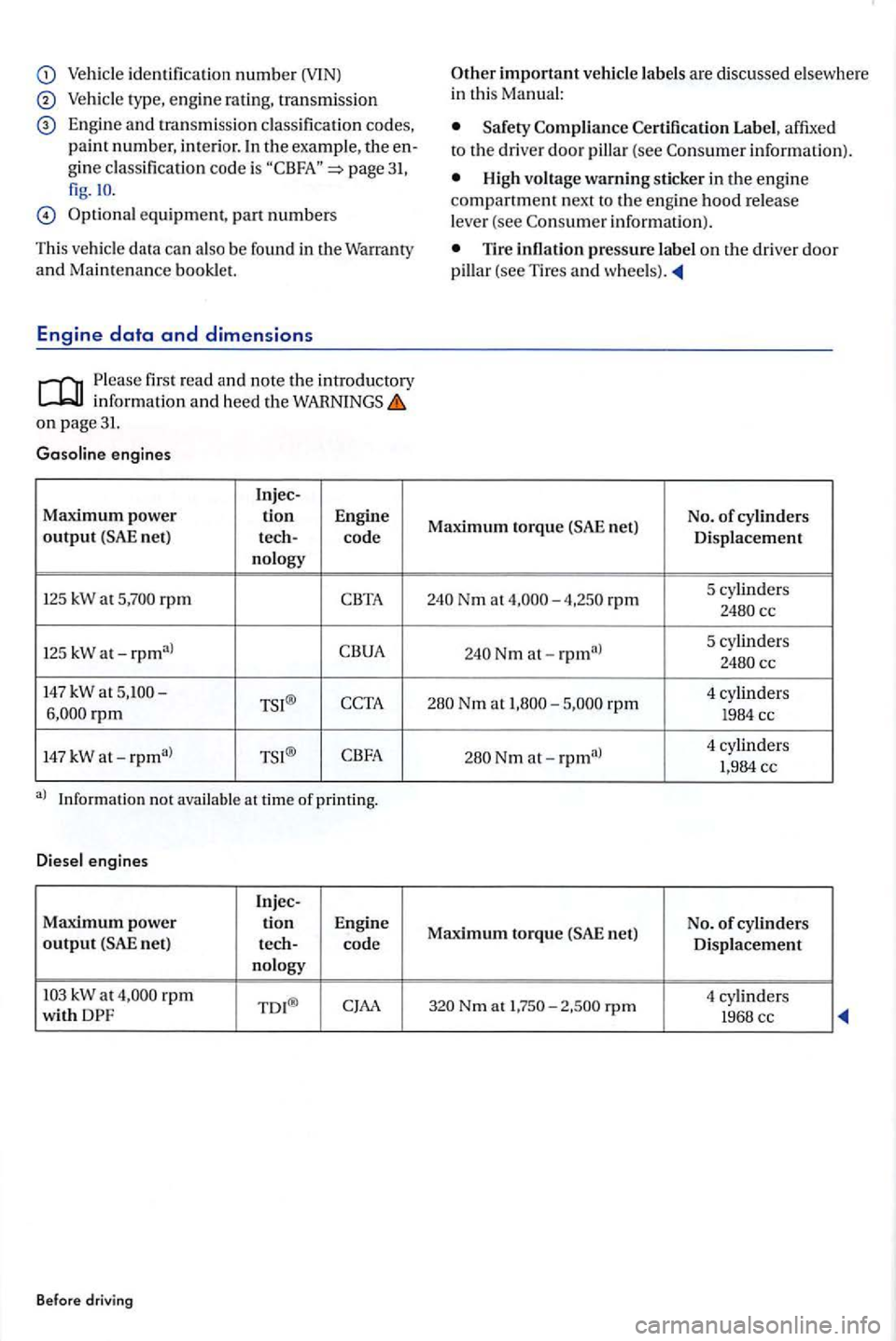
identificatio n number (VlN)
Veh icle type, eng in e rating , tran smission
E n gine and tra nsm iss io n classificatio n cod es, pain t num ber, interior. In the exa mple,
3 1, fig.IO.
equipment, part num bers
Thi s ve
hicle data can also b e fou nd i n t he War ra nty
and Maintenan ce booklet.
Engine data and dimensions
first read and note the in trod uctory inform ation and heed th e WARNINGS on page31.
G aso line engi nes
Injec -
Maxim um power
rp m
125 kW at-
147 kW at
kW at rpm T D I®
Before dri ving
Safety
i nfo rmatio n).
Hi gh vo ltage warning sticker in the en gin e compartment next to the eng ine hood r elease leve r (see in format ion) .
Tire infl ati o n pressure la b el o n th e driver door
pillar (see Tires and
Maximum torqu e net) N
o. of cy linders
Disp laceme n t
Nm at rpm 5 cy linders
5 cy linders
N m at-4 cylinders
1 ,984 cc
Max
imum torque n et) N
o. of cy lin ders
Di sp lacement
N m at rp m 4 cylinde
rs 196 8 cc
Page 139 of 541
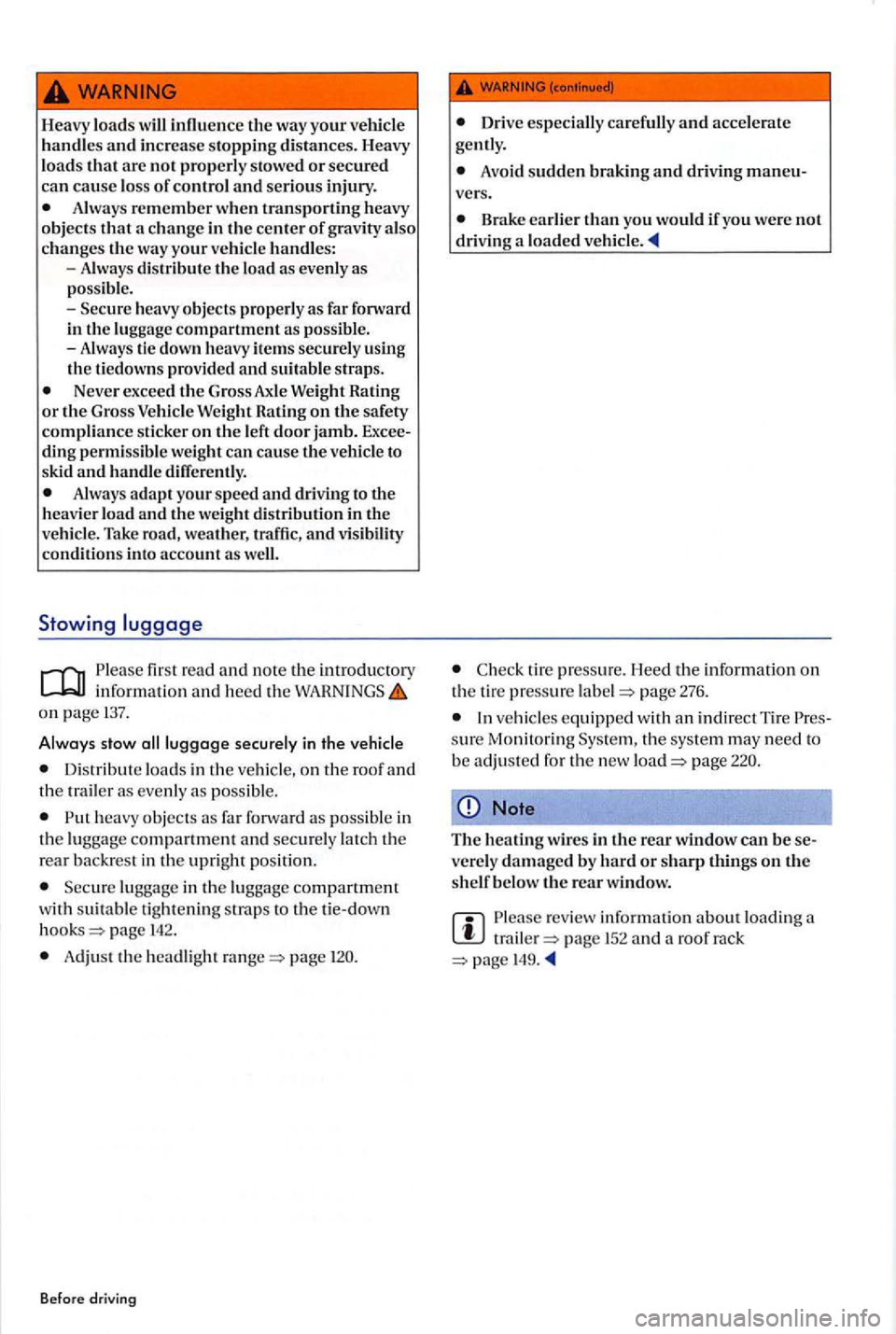
Heavy loads innuence th e way your vehicle handles and increa se stopping distances. Heavy
load s that arc not properly stowed or secured can cause los s of contro l and serious injury . Always remember when transporting heavy
objects that a change in the center of gravity also
changes the way your vehicle handles:
- Always dis tribute the load as evenly as
possib le. -heavy objects properly as far forward
in th e luggage compa rtme nt as possible.
- Always tie down heavy items secure ly using
th e tiedowns provided and suitable straps.
Never exceed th e Gross Axle Weight Rating or the Gross Vehicle Weight Rating on the safety compliance sticker on the left door jamb. Excee
ding permissible weight can cause the vehicle to
skid and handl e diff erentl
y.
Always adapt your speed and driving to th e
heavi er load and the we ight distribution in the
vehicl e. Take road, weathe r, and visibility
cond itions into acco unt as we ll.
Stowing
on page 137.
Always stow all luggage securely in the vehicle
Distribut e loads in the vehicle, on th e roof and the trail er as even ly as possible.
Secu re lu ggage in the luggag e compartment with suit able tightening strap s to the tie-down page 142.
Adjust the headli ght page
Before driving
Drive especia lly carefully and accelerate
gently.
Avoid sudden braking and driving maneu
ve rs.
Brake earlie r than yo u would if you were not driving a loaded
tire pressure. Heed the information on the tir e pressure page 276.
sure Monitor ing Syste m, the system may need to
be adjusted for the new page
CD Note
The heating wires in the rear window can be se
vere ly damaged by hard or sharp things on the sh elf below the rear window.
review inf ormation about loading a page 152 and a roof rack 149.
Page 156 of 541
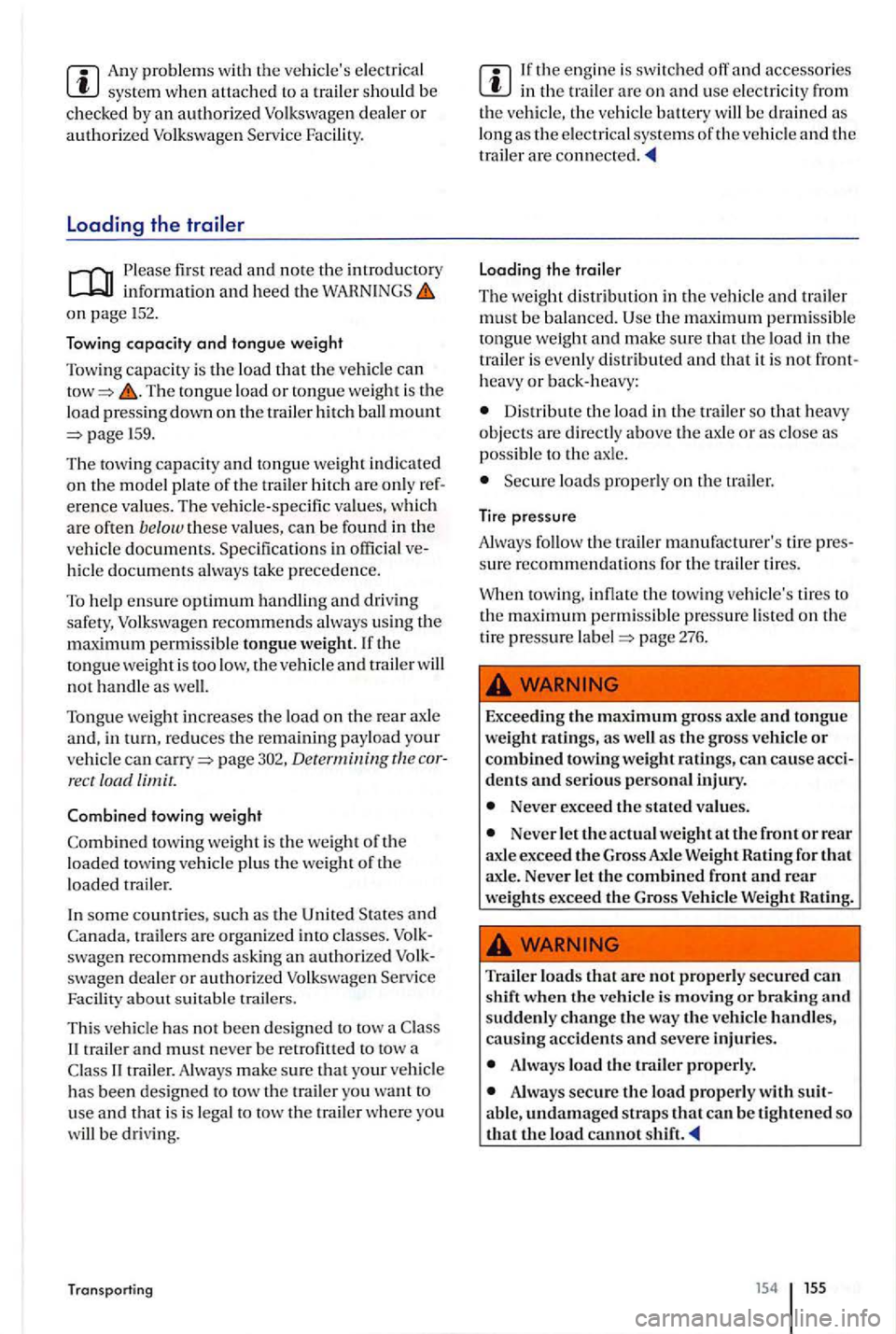
Any problems with the vehicle's elec trica l system when attached to a trailer should be chec ked by an authorized Volkswagen dealer or authorized Volkswagen Service Facility.
Loading the trailer
Pleas e first read and note the introductory information and heed the on page 152.
Towing capacity and tongue weight
Towing capac ity is the load that th e vehicle can
159.
The towing capacity and tongue weigh t indicated on the model plate o f the trail er hit ch are only re f
e ren ce value s. The vehicle-specific values, which are often below these values, can be found in the vehicle document s. Specificat ions in officia l ve
hicl e documents alwa ys take precedence.
To help en sure optimum handling and driving safe ty, Volkswagen recommends always using the
not handle as well.
Tongue weight increases the load on the rear axle and, in turn, reduces the remaining pay load your ve hicl e can cor
rect load limit.
Combined towing weight
towing weight is th e we ight of the
l oaded tow in g vehicle plus th e we igh t of th e
l oaded trailer.
In some countries, su ch a s th e States and Ca nada, trailer s are organ ize d in to cla sses. swagen recommend s askin g an authori zed swage n dealer or auth orized Volksw agen Se rvice
Facili ty about suitabl e trailer s.
Thi s
vehicle has not been desig n ed to tow a traile r and must n eve r be retrofitted to tow a II trailer. Always make sure that your vehicl e has been designed to tow the trai le r you want to use and that is is legal to tow the traile r where you be driving.
T ronsporting
Loading the trailer
The weig ht dist ribution in the vehicle and tra iler
mu st be balanced. th e maximum permissible
tongue weight and make sure that the load in the
trail er i s eve nly di stributed and that it is not front
h eavy or back-heavy:
Distribut e th e load in th e trail er so that heavy objec ts are directly above the axl e or as close as
po ssibl e to the
Secu re load s properly on the trail er.
Tire pressure
Always follow th e trail er manufac turer' s tir e pres
s ure recommendations fo r the trailer tires.
W h
en towing, inflat e th e towin g vehicl e's tir es to the maximum permissible press ure listed on th e
tir e pressure la bel pag e 276.
Exceeding
the maximum gross axle and tongue weight ratings, as well as the gross vehicle or combined towing weight ratings, can cause accidents and serious personal injury.
Never exceed the stated va lues.
Never let the actual weight at the front or rear axle exceed the Gross Axle Weight Rating for that
axle. Never let the combined front and rear weights exceed the Gross Vehicle Weight Rating.
Trailer loads
that are not properl y secured can shift when the vehicl e is moving or braking and suddenly change the way the vehicle handles,
causing accidents and severe injuries.
Always load the trailer properly.
Always secure the load properly with suitable, undamaged straps that can be tightened so that th e load cannot shift.
154 155
Page 201 of 541
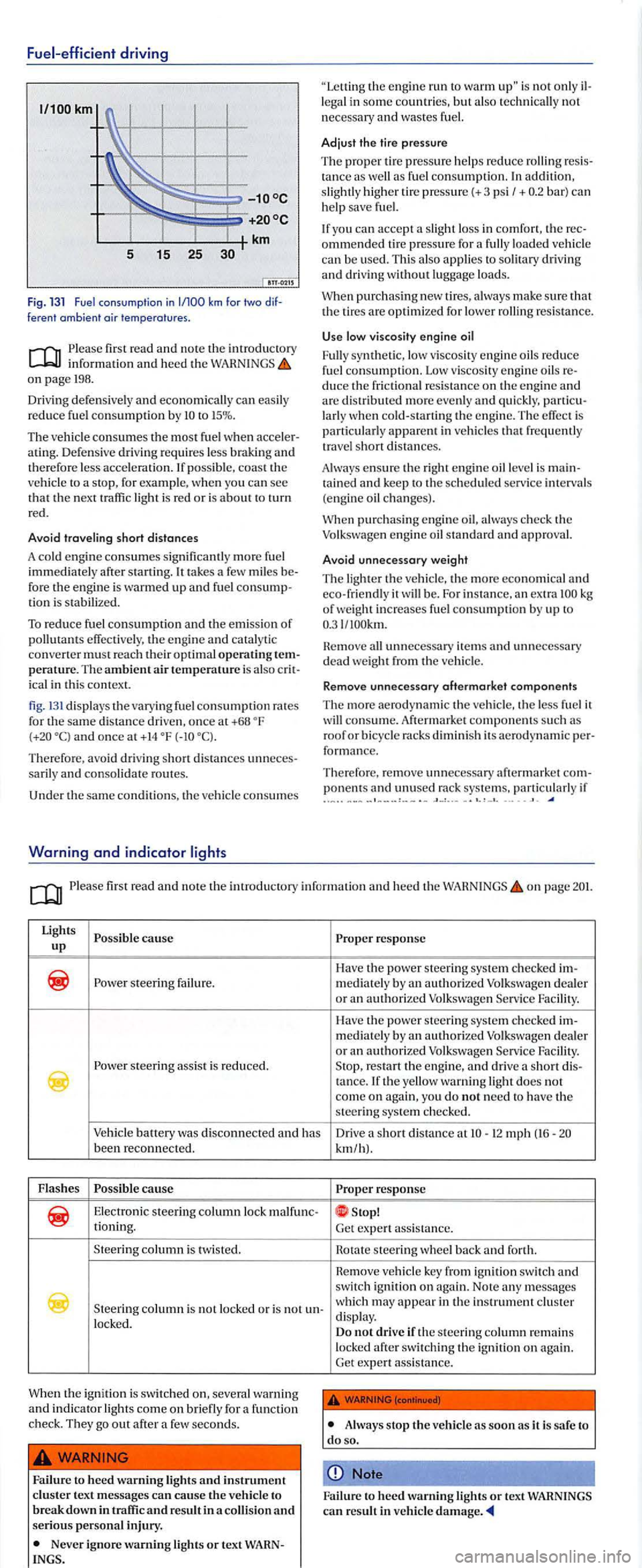
Fuel-efficient driving
Fig. 131 Fuel consumption in ferent ambient air temperatures .
info rmation and heed the on page 198.
Dri vin g defensive ly and economically can easily
r educe fuel con sumption by to 15 % .
The ve hicle consu mes the most fu el w he n atin g. D efe nsive dri vin g require s less brakin g and therefore less accelerat ion. If possib le, coast the ve hicle to a sto p, for exa mple, when yo u ca n see th a t th e next traffic ligh t is red or is about to turn
red.
Avoid traveling short distanc
es
A cold engine consumes sig nificantl y more fuel
imm ediately after sta rtin g. It take s a few miles fore the engi ne is warm ed up and fuel tion i s stabili zed.
To reduce fuel consumptio n and the emission of pollutants effect ive ly, the e ng in e and ca talytic
conve rter must reach th eir optimal operating
ica l in thi s context.
fig. 13 1 displays the v a ry ing fuel consumption rates
for the same d istance dri ven, once at +68 and once at + 14
th e e ngin e run to warm is not o nl y lega l in some co untries, but also technicall y not
n ecessary and wastes fu el.
Adjust the tire pres sure
T he prop er tir e
pressure help s reduce rollin g tance as well as fue l co nsumption. In additi on ,
slig htl y higher tire pressure(+ 3 psi I+ bar) ca n
h e lp save fuel.
If you ca n a ccept a slight los s in comfort, the ommend ed tir e pressure for a fully loade d ve hicl e
ca n be used. This als o applies to so litary dri vin g and driv ing withou t lu ggage loa ds.
When purchasing new t ires, alway s ma ke sure th at
th e tires are optimi zed for lower rollin g resis tance.
Us e low viscosity engine oil
F ull y sy nth e
tic, low viscosity e ngine oils reduce
fuel consumption. Low viscosity e ngin e oils duce the fric tional res istance on th e engine and are dis tributed m ore evenly and qui ckly, larly w hen co ld -s tarting the engine. The effect is parti c ularl y apparent in vehicles th at frequentl y
tra vel s hort dis tan ces.
A lways ens
ure th e righ t e n g in e oil leve l is ta in ed and keep to the sc h edul ed serv ice interva ls
(e ng ine oil ch an ges).
W
hen purch asing e ngine oil, always ch eck th e Volksw agen en gine oil standard and approval.
Avoid unnecessary weight
The lighter th e ve hicl e, th e more economica l and ceo-friend ly it w ill be. For in stance, an extra
H e m ove
consum e. Aftermark et co mponents s uch as
ro of or b icycle racks dimin is h its aerod yn a m ic fonnan ce.
Th erefo re, re
mov e un necessary aftermark e t ponents and unused rac k systems, parti cul arly if ....... -
fir st read and note th e introductory informa tion and h ee d th e WAHNINGS page
response
Ha ve the power stee rin g sys te m ch ec ked ste eri ng failure. mediatel y by an authori zed Volk swag en deale r
o r a n authorized Volk swagen
Fac ility. steeri ng ass is t i s reduced. re start the e n gine, and dri ve a sh ort tan ce. If th e yello w warning light does not
c o m e on again, you do not need to have th e
s te ering syste m ch ec ke d .
Vehicle battery was di sconnected and has Drive a short distan ce at 12 mph been reconnec te d . km/h).
F lashes re sponse
Elec troni c steering column lo ck malfunc -
which m ay appea r in the in strument clu ste r
di sp lay. loc ke d.
W
hen the i g nit ion is switc h ed on, seve ra l wa rnin g and indicator lights come on bri efly for a f un ction ch e ck . T hey go out after a few seconds.
Failure to
heed warning light s and in strument cluster text m essages can cause th e vehicl e to break down in t raffic and result in a collisio n and seriou s personal injury.
Neve r igno re warning lights or tex t
Do not dri ve if th e s teerin g co lumn remains
l ocke d switch in g th e ig niti on on aga in.
Ge t expert assis ta nce.
Alwa ys sto p the vehicl e as soon as it is safe to do so .
Note
Failur e to heed warning lights or tex t WARNINGS can res ult in vehicl e damage
Page 218 of 541
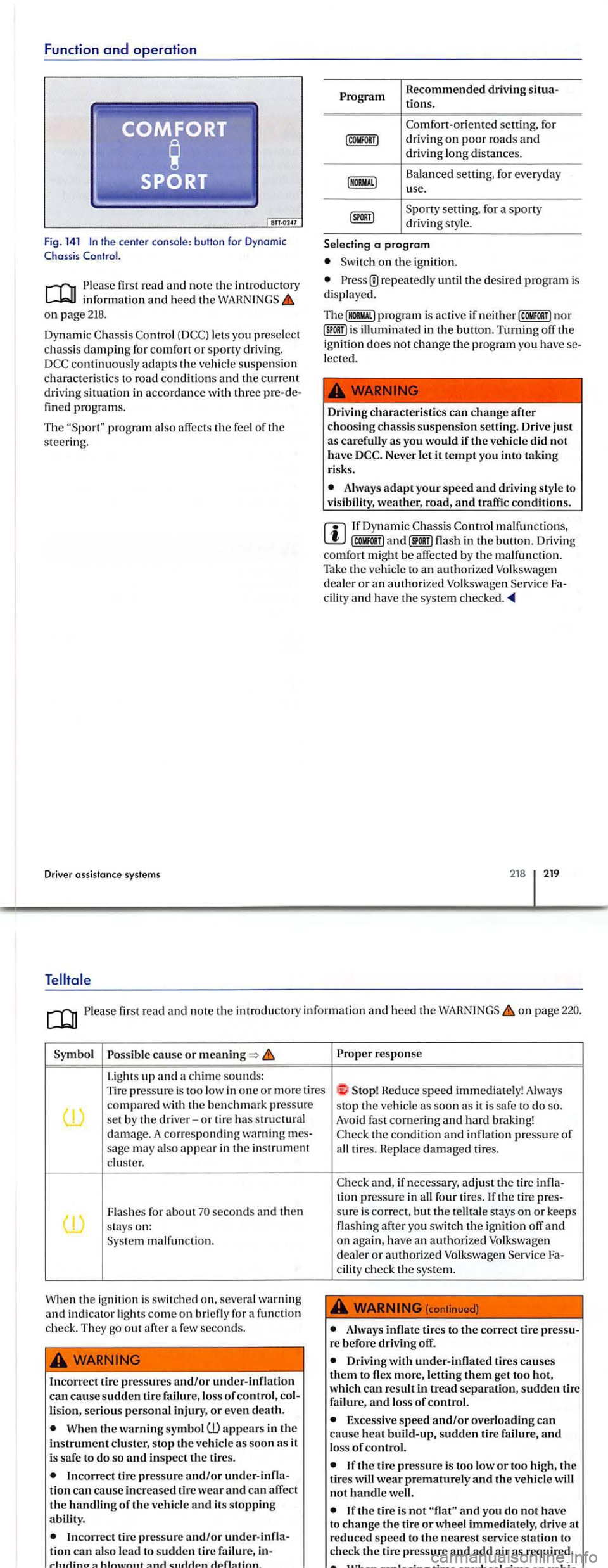
Function and operation
Fig. 141 In the cen te r co nsole : b uHon fo r Dynomic C hoss is
Please read and note th e introductory inf ormati on and hee d t he on page 218.
D ynamic C hassis Control lets you prese lec t
chassi s dam ping for comfo rt or sporty driving .
pro grams.
T he
program also affec ts th e feel of the steering .
Driver assis tanc e systems
Program R
ecommended driving
Comfort- oriented setting, for driving on poor roa ds and driving lon g di sta nces .
Balanced
setting, for everyday
u se.
a program
o n th e ignition.
re p ea te dl y th e des ired progra m is
disp laye d.
Th e
nor illumin ated in the button. Turning off the
i g nition does no t chan ge the program you have lec ted.
Driv ing characteristics can
change after choosing chassis suspension setting. Drive just as carefully as you would if the vehicle did not
h ave Neve r let it tempt you into takin g
risks.
Always adapt your speed and driving style to
visibil and traffic condit ions.
malfunctions , flash in the button. Driving comfo rt might be affec te d b y th e malfunction. Tak e th e ve hicl e to an authorized Volk swage n
d ea ler or an authorize d Volkswa gen
218 219
Please read and note the introdu ctory information and h eed the WARNINGS on page
Poss ible cause or
Lights up and a chime sounds: Tire pressure is too in one o r more tires compa re d wi th th e ben chmark press ure
se t by the driver-or ti re has stru ctural
damage. A co rre spo ndi ng warning
sa ge may also app ear in the instrument cluster.
Fla s hes for abo ut seconds and then stay s on: malfun ction.
W h
en the ignition i s s witched on, severa l warning
a nd ind icato r light s come on briefly fo r funct ion
c h ec k. Th ey go out after a few seco nds.
Incorrec t lire pressures and/or under- inflati on can cause sudden tire failure , loss of control , lisio n, seriou s personal injury, o r even death.
When the warning symb ol
In correc t tir e pressure a nd/or tio n can ca use incre a se d tir e wear and ca n affe ct the handling of th e ve hicle and its stoppin g
Incor rec t tir e pressure and/or ti o n can also lead t o sudden tir e fa ilu re,
Proper response
Heduc e speed imm ediately! Always
s t
op th e vehicle as soon as it is safe do so . Avoid fas t cornerin g and hard braking!
tion press ure in all four tires. If th e tir e
cilit y c heck the sys tem.
(continued)
Always inflate tires to the correct tire re befor e drivin g off .
Driv in g with under-inflat ed tire s causes them to flex more, letting the m get too hot,
which can
Excessive speed and/or over loading can
ca use heat build -up, sudden tire failure , and lo ss of control.
If the tire pressure is too low or too high , th e tires wear prematurely and the vehicl e will
not handl e we ll.
If the tire is not and yo u d o no t h ave
t o ch an ge the tire or whee l immediat ely , drive a t
reduced spee d to the nearest serv ice station to
c h eck th e tir e pressure and add
Page 219 of 541
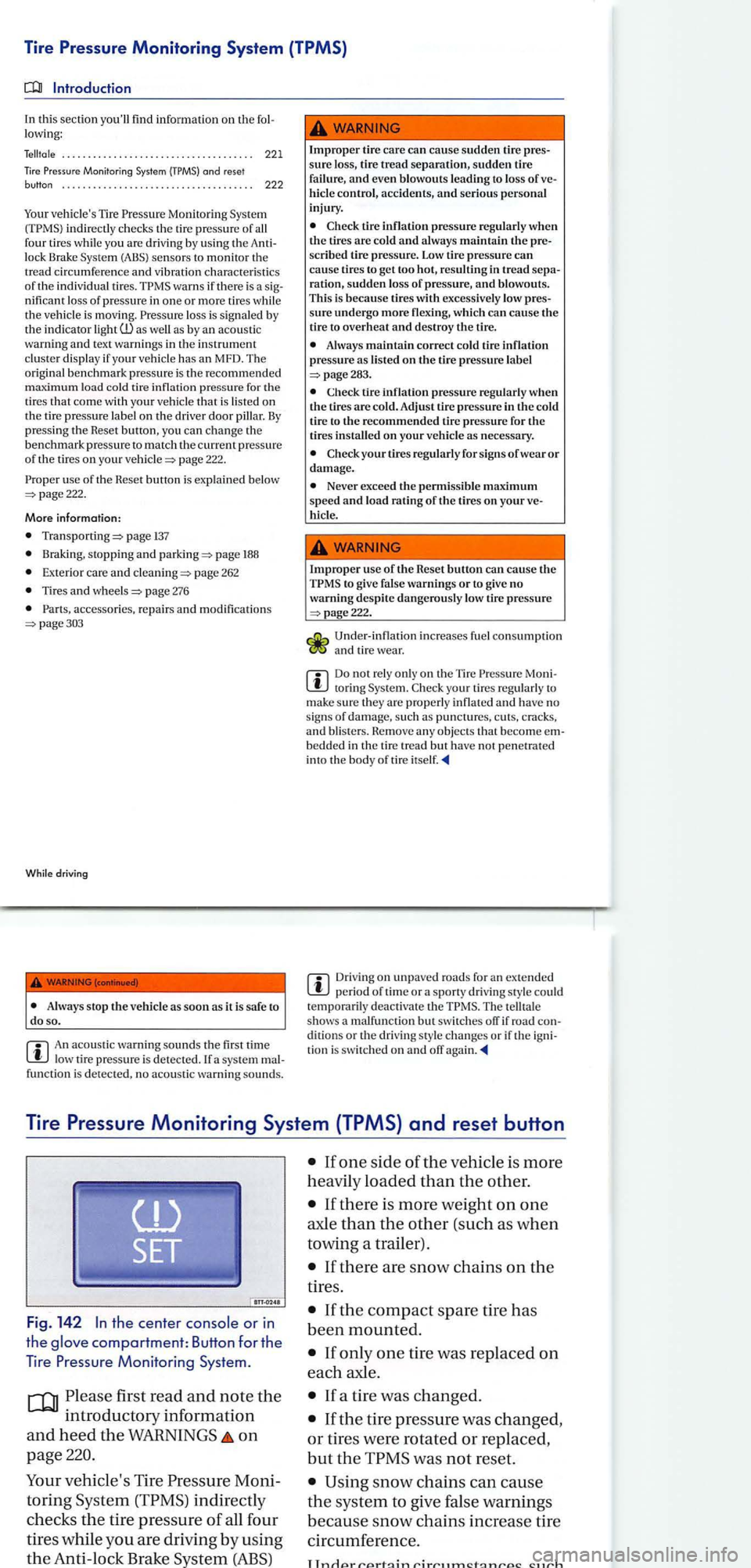
Tire Pressure Monitoring System (TPMS)
this section you'll find informati on on th e lowing:
. . . . . . . . . . . . . . . . . . . . . . . . . . . . . . . . . . . . . 221
Monitor ing System
Monito ring Sys te m indirectly c hecks the tire pressure of all
f our tires while you are driving by us ing the lock Brake Syste m (ABS) sensor s to monitor the
tr ea d circumf erenc e and vibration ch arac te ris tics of the indi vidua l tir es. warns if there is a nifi cant loss of pres sure in one or more tires while
the vehicl e is mo vin g. loss is s ig nale d b y
the ind icato r light as by an aco usti c
wa rni ng and text warnin gs in the in strument clu ster di spla y if your ve hicle has an MFD. The
origina l b en chmark pre ssure is th e recommended
m axi mum load cold tire inflati on pressure for the tire s that come with your vehicle that is lis te d on
th e tire pressure lab el on the dri ver door pill ar. By press ing the Reset button , yo u can ch ange the
b enchmark pressure to match th e c urr ent pressure of the tir es on you r page 222.
use of the Heset butto n i s explained below 222.
More informa tion:
page 137
Bra king, stopping and page 188
Ext e rior care an d page 262
page 276
pa ge303
Whil e driving
An acoustic warni ng sounds th e first time low tire pressure is detec ted. a system
Improp er tire care can cause sudden tire sure loss,
hicle control, accidents, and serious personal
injury .
tire inflation pressure regularl y when the tires are cold and alway s maintain the scribed tire pressure . Low tire pressure can cause tires to get too hot, res ultin g in tread ration, sudden lo ss of pres sure, and blowout s.
Thi s is because tires with excessively low
sure undergo more flexi ng, which can cau se the tir e to overheat and destroy the tire.
Always maintain correct cold tire inflation pressure as listed on the tire pressure label
Check tire inflation pressure regularl y when the tires are cold. Adjust tir e press ure in the cold
tir e to the recommended tire pressure for t11e tires installed on your vehicl e as necessary.
Neve r exceed the permissi ble maximum speed and load rating of the tires on your hicl e.
Imprope r us e of the Reset button can cause the to give false warnings or to give no
warning des pite dangerou sly lo w tire pressure
page222.
Und er- inflat ion increases fue l con sumptio n and tire wear.
to ring Syste m.
bedde d in the tir e tre ad but have n o t penetrated
int o the body of tire
Driving on u npaved roads for an extended
The te lltal e
s h ows a malfunc tion but switch es orr if road dit io ns or th e drivin g sty le c han ges or if th e tio n is switch ed on and orr
Tire Pressure Monitoring System (TPMS) and reset button
the center or in
the compartment: Button for th e
T
ire Pressure Monitoring System.
first r ead and note the
introductory informatio n
and heed the WARNINGS on
page
ve hicle's Tir e Moni
torin g
indirectly
c h ec ks
the ti re pressure of al l four
tire s while yo u are drivin g by us
ing
the Anti -loc k
If there is more weight on one
axle than the other (such as when
towin g a trailer) .
Page 220 of 541
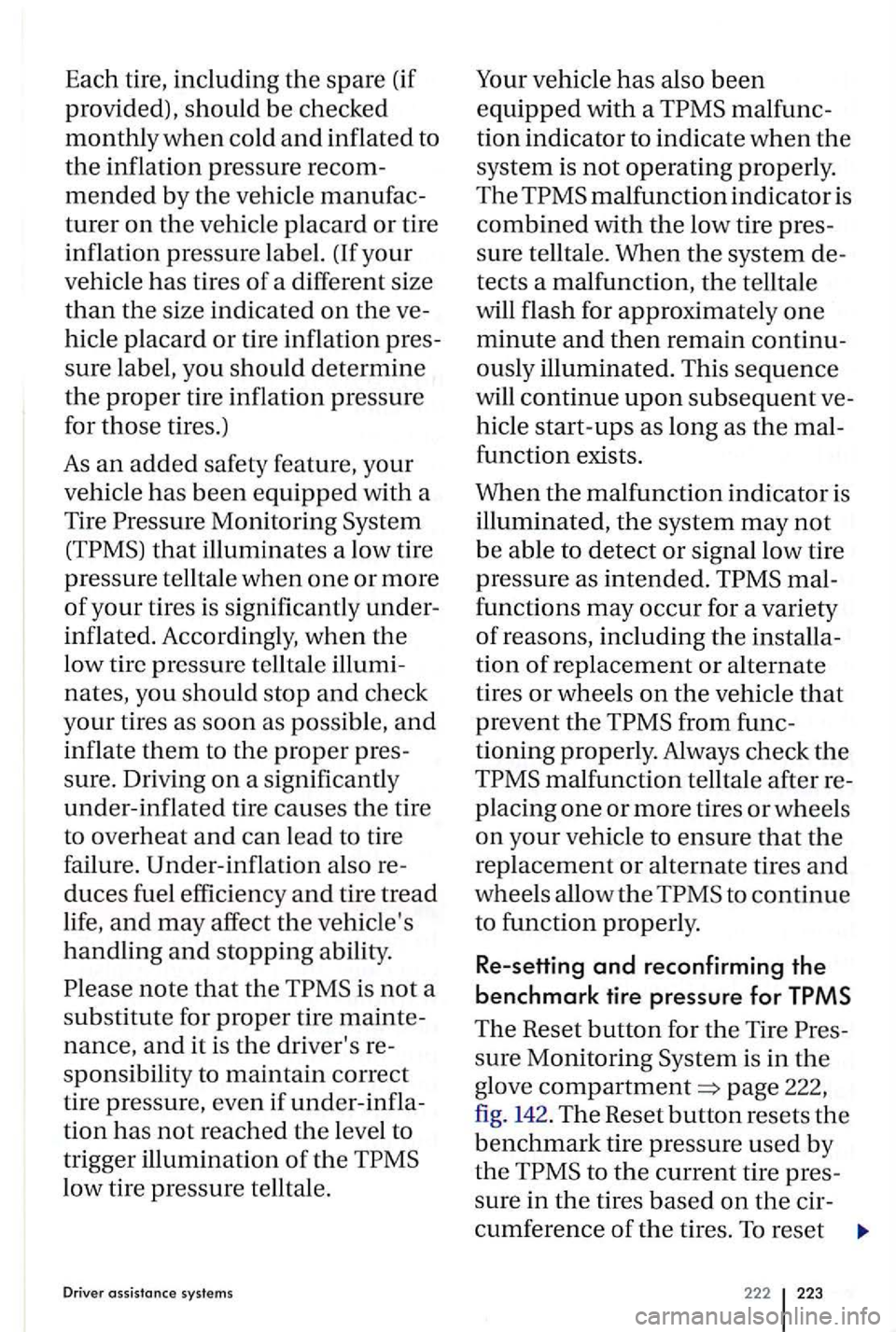
Each tire, including the spare (if
provided),
should be checked
monthly w hen cold and inflated to
the inflation pressure recom
mended by the vehicle manufac
turer
on the vehicle placard or tire
inflation pressure label.
(If your
vehicle
has tires of a different size
than the size indicated on the ve
hicle placard
or tire inflation pres
sure label, you sho uld determine
the proper tire inflation pressure
for
those tires.)
As an added safety feature, your
vehicle
has been equipped with a
Tire
is not a
substitute for proper tire mainte
nance,
and it is the driver's re
sponsib ility to
maintain correct
tire pressure , even if under-infla
tion
has not reached the level to
trigger illumination
of the
low tire pressure telltale.
Driver assistance systems
Your vehicle has also been
equipped with a malfunc
tion indicator to indicate
when the
system is not operating properly.
The
malfunction indicator is
combined with the low tire pres
sure telltale. When
the system de
tects a malfunction, the telltale
will flash for approximate ly
one
minute and then remain continu
ously illuminated. This sequence
will continue upon subsequent ve
hicle
start-ups as long as the mal
function exists.
When
the malfunction indicator is
illuminated, th e system may not
be able to detect or signal low tire
pressure
as intended.
to continue
to function properly.
Re-setting and reconfirming the
benchmark tire pressure for TPMS
The Reset button for the Tire
sure Monitoring is in the
glove compartment=> page 222,
fig. 142. The Reset button resets the
benchmark tire pressure used by
the
to the current tire pres
sure
in the tires based on the cir
cumference
of the tires. To reset
222 223
Page 221 of 541
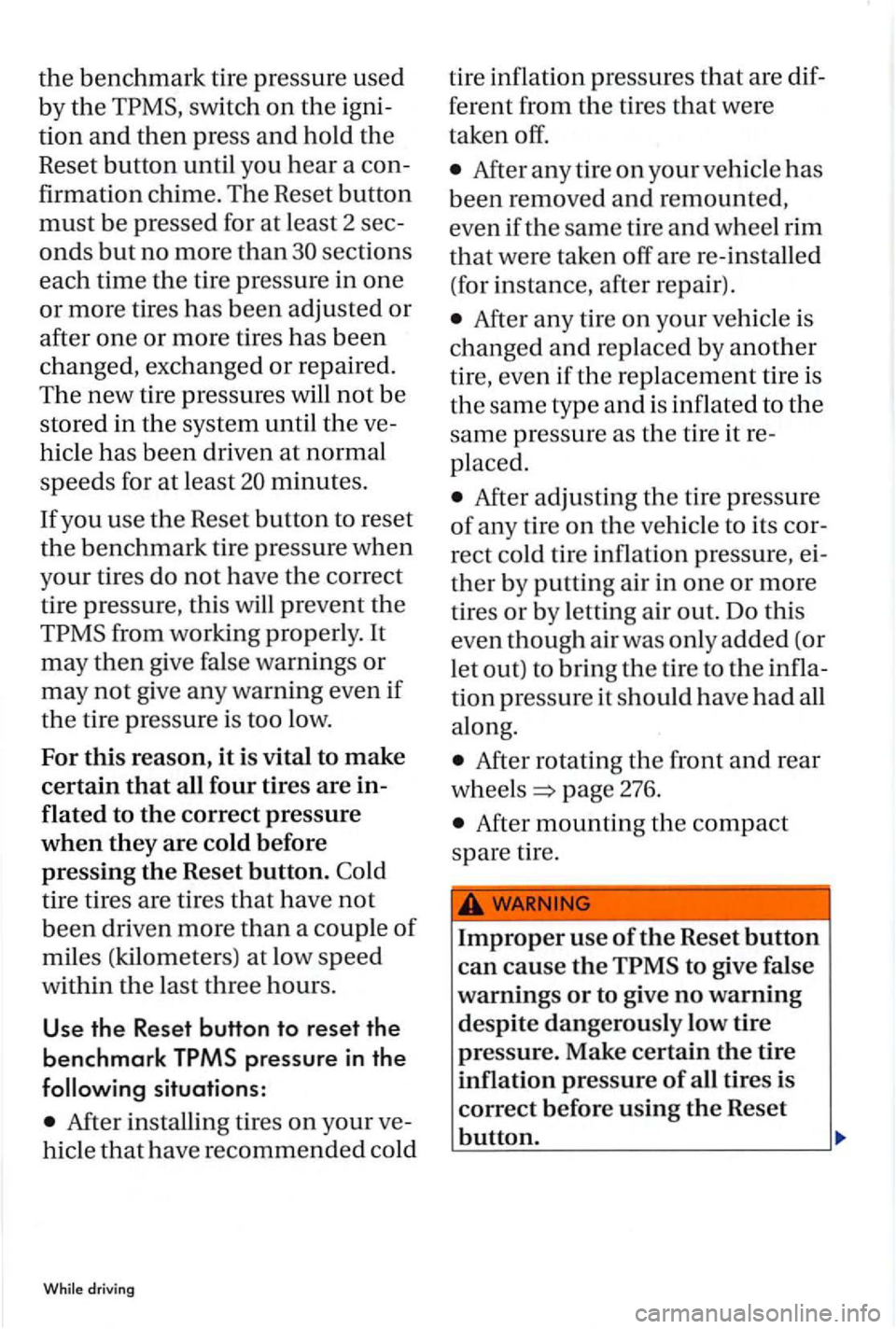
the benchmark tire pressure used
b y
the swi tch on the igni
tion
and then press and hold the
Reset button until you hear a con
firmation chime. The Reset button
must be pressed for at least 2 sec
onds but no more than sect ions
each time
the tire pressure in one
or more tire s has bee n adjusted or
after
one or more tires has been
changed, exchanged or r
epaired.
The new tire pressures will not be
st
ore d in the system until the ve
hicle has b
een driven at normal
s p eeds for
at leas t minutes.
If you use the Reset button to reset
the ben chmark tire pressure when
yo
ur tires do not have the corre ct
t ir e pressure, this
will prevent the
After installin g tires on your ve
hicle
that h ave recom mended co ld
driving
tire infl ation pressures that are dif
ferent from the tires that were
taken off.
After any tire on you r ve hicl e has
b
een removed and remounted,
even if t he sa me tire
and w hee l rim
that were taken off are re-insta ll ed
(for instance, after repair).
After a ny tire on you r veh icle is
changed
and r ep lace d by another
tire, even if th e rep lace me
nt tire is
th e
same type and is inflated to the
same press ure as the tir e it re
pl ace d.
After adjusting the tire pressure
of an y tire on the ve hicl e
to its cor
rect cold tire in flation pressure, ei
ther by putting air in one or more
tires
or by let tin g air out. Do this
even though air was o
nly added (or
let out)
to bring the tir e to the infl a
tion pressure it should have had all
along .
After rotating the front and rear
w he els
page 276.
After mounting th e compact
s pare tir
e.
Improper use of the Reset button
can cause the to give false
warnings
or to give no warning
d espite dangerously low tire
pressure. Make certain
the tire
inflation pressure
of all tires is
correct before using
the Reset
button.
Page 222 of 541
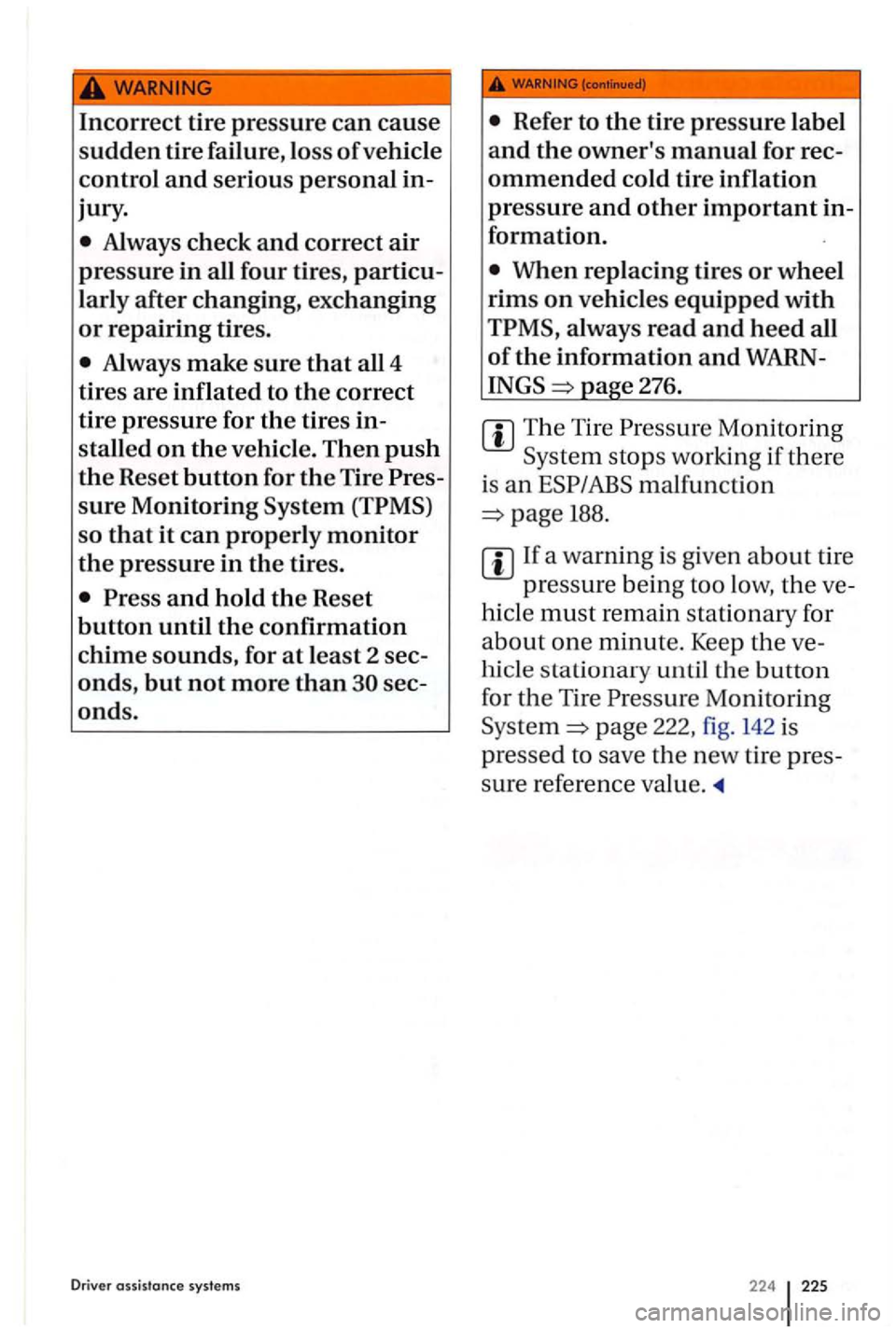
Incorrect tire pressure can cause
sudden tire failure, loss of vehicle
control and serious personal in
jury.
Always make sure that all 4
tires
are inflated to the correct
tire pressure for the tires in
stalled on the vehicle. Then push
the Reset button for the Tire
sure Monitoring System
so that it can properly monitor
the pressure in the tires.
always read and heed all
of the information and WARN
page 276.
The Tire
malfunction
If a warning is g ive n about tire
pressure
being too low, the ve
hicle
must remain station ary for
about one minute. Keep the ve
h icle stationa1y until the
button
for the Tire
page 222, fig. 142 is
pressed to save the new tire pres
s
ure reference value.
224 225